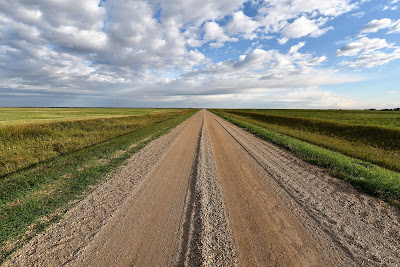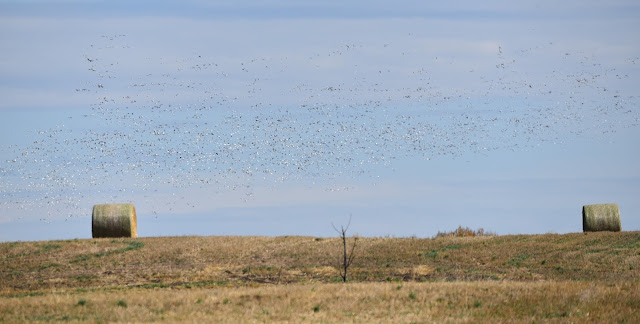Fall Migration : Fish Creek NHS to St. Laurant Ferry
Last night was very noisy, and not conducive to sleeping. When we set up the tent under the roofed shelter the wind had temporarily died down, but shortly afterwards it kicked back up with a vengeance. Because the shelter had a wooden floor, we secured the corners of the tent with our water jugs, and tied the guy wires to the picnic table. The arrangement wasn't too secure, and no amount of adjustments throughout the night stopped the loud flapping of the fly. The roof sheltered us from the unexpected rain showers, but it may not have been worth the trade-off. To cap it off, a group of coyotes hunted in the ravine beside the shelter all night, yipping and barking as they circled around and around, and one of them came up into the shelter to give our tent and gear a thorough sniff. Thankfully it didn't decide to scent-mark the carts!
As the sun rose above the horizon, bathing the landscape in warm golden light the honking of hundreds of Snow and Canada Geese again filled the skies above us. Closer to earth, we discovered a beautiful green catydid with lovely red eyes on the roof of our tent. Looking around as we made coffee and read some of the interpretive signs, it was amazing to imagine that over 100 years ago the now peaceful ravine in front of us was the site of a battle where musket and cannon fire were exchanged between Métis and government forces.
When we headed out of the National Historic Site we realized it is one of the key locations on the Trails of 1885 route. These points of historical significance are scattered throughout Manitoba and Saskatchewan and commemorate the significant events of the North West Resistance in 1885. We have already visited the Riel House near Winnipeg, Manitoba which is part of the Trails of 1885, and we will visit several other sites of historical importance along it in the coming days.
As we made our way down the gravel road, heading north along the shore of the South Saskatchewan River, we spotted a geocache hanging from a Trans Canada Trail marker. We've tried to find at least one cache per province as we hike across the country, so how could we resist logging one that is literally attached to a trail marker?
We made our way along, past small farms located along the river and many picturesque abandoned wooden buildings. The most impressive by far was the large wooden Roman Catholic church at Fish Creek, which was formerly known as the Immaculate Conception Church. It was built in 1920 to replace an earlier structure that was destroyed by fire, and it closed in 1957. Although it is now privately owned, closed to the public, and at least partially boarded up after standing empty for over half a century, it still stands as a beacon commemorating the area's rich cultural and religious heritage.
The community of Fish Creek was established by the Métis in the late 1800's, and they were later joined by settlers of Polish and Ukrainian descent. Early settlers established long narrow properties along the river that were approximately 200 m wide and 3 km long, and which afforded them access to water. The Fish Creek Church is perhaps the most evident reminder of the past community, but the distinctive farms and the nearby Fish Creek Cemetery also serve as reminders of what came before us.
The bright colours of the fall foliage on the treed slopes of the river gave the cool, windy, overcast morning a warm glow as we left Fish Creek behind. We noticed many Prairie Garter snakes of all sizes warming themselves on the road this morning. This was by far the highest density of snakes we've noticed anywhere on the prairies! We also saw an abundance of woolly bear caterpillars scurrying across the road - another sign of autumn.
As we walked along the river we enjoyed seeing the variety of unique glass fronted homes and interesting farms that were located along its banks. One farm stood out because it was a very tall, narrow, un-symmetrical red building with several levels of sloped roofs that reminded us of something you might find in Harry Potter's world. It was surrounded by outbuildings which seemed to house various animals, including goats and pigs. Little did we know we'd meet the owners!
As the kilometres ticked by we found a rare place to step off the gravel road onto a lane used to access a field and were taking a break when a pickup truck stopped beside us. It turned out to be Kevin and his enthusiastic family, who lived in the magical looking farm! After hearing about our adventure they very kindly invited us to stop by, and offered any kind of help we needed. Too bad we were heading in the other direction! It was wonderful meeting them, and getting a chance to answer the kid's questions! Not two minutes after they drove away another couple stopped to make sure we weren't lost and didn't need any help. We were blown away by so much kindness in one stretch, and there was more to come! We haven't experienced such warm and spontaneous hospitality since hiking the T'Railway Trail in Newfoundland!
Another treat was experiencing a second day of watching the skies come alive with geese. Large groups of Snow Geese seemed to move as one - the light morphs, with their white bodies and black wing tips mixing with the blue morph, which appeared to have dark bodies and striking white heads. Together they seemed to sparkle and shimmer as they moved through the vast skies. Surely an impressive sight to behold!
Around mid-morning we passed the One Arrow Powwow Grounds. Each year in June the Solstice on the South Saskatchewan festival is held here, which is a multi-genre music, art, and cultural gathering. It is held on the longest day of the year, and features Canadian and International artists alongside local favourites. The festival is located at the place where Gabriel Dumont crossed the Saskatchewan River with his men, and it is now home to the One Arrow First Nation.
The One Arrow First Nation is a Cree First Nations band government which is named after Chief One Arrow who was a signatory to Treaty Six at Fort Carleton in 1876. They had land disputes with the Métis of Batoche in the 1800's, and their role in the North West Resistance is somewhat controversial. Chief One Arrow claims they were coerced into fighting alongside Louis Riel, whereas the Métis claim they were willing allies. More recently, the One Arrow Reserve was the birthplace of singer, song writer, and actor Thomas Dale Jackson, who starred in the iconic TV shows 'North of 60' and 'Star Trek: The Next Generation' among others.
We crossed highway 312 and suddenly found ourselves on a paved road, which is an extremely rare treat out here on the prairies. As we glided easily along with our carts we passed a very nice looking campground which hadn't appeared on any of our maps, but which was closed in any case.
Shortly afterwards we arrived at the Batoche National Historic Site of Canada, which we had been looking forward to visiting. Disappointingly, its gates were closed and locked when we arrived, preventing us from visiting the grounds. The site features a Visitor's Center dedicated to bringing the history and culture of the Métis alive, offers tours of the Church of St. Antoine de Padoue and its rectory, which apparently still has bullet holes above the door from the advancing militia during the Battle of Batoche. Hiking trails allow exploration of the ridges and trenches where the Métis took a stand against the North West Forces, and visitors can explore the Caron homestead and the archeological remains of the village. The grave of General Gabriel Dumont is also located at the site.
The events that took place here are historically significant because the Battle of Batoche was the decisive battle in the North West Resistance. Over the course of four days, from May 9th to 12th 1885, the Canadian Government's forces, under the command of General Frederick Middleton, defeated the Métis forces and their First Nations allies, who were under the command General Gabriel Dumont. This defeat led to the surrender of Louis Riel on May 15th, and the collapse of his provisional government, which was located in Batoche. Other leaders of the resistance, including the Cree Chiefs Poundmaker and Big Bear soon surrendered as well, effectively bringing the resistance to an end. This left the Canadian Government in a stronger position to continue settling the west, and to resist annexation by America.
After taking a break at the gates of the Batoche National Historic Site we continued to follow the river north, first along the pavement, and then a bit farther after it turned to gravel. Eventually we reached the St. Laurent Ferry, where we crossed back over the South Saskatchewan River. Close to this spot is another point of interest along the Trails of 1885. St. Laurent was the first permanent Métis settlement along the South Saskatchewan River, and the Our Lady of Lourdes St. Laurent Shrine still marks the location of this historic community.
The ferry operator on this crossing was a very friendly Indigenous man who chatted with us during the crossing and made no bones about telling us he thought we're crazy for walking so far. He's probably right. The water at this crossing looked deeper than at the Hague Ferry, and we made the short crossing with two other vehicles.
We took a short break on the far side of the river, stopping to watch the Belted Kingfisher that was perched on the ferry cable above the river, and the group of Greater Yellowlegs that was fishing among the rocks in the river.
As we sat on the grassy slope a car stopped and a lovely couple on their way home from church stopped to chat with us. They knew about the trail, which passes close to their community of Horse Lake, and they ended up sharing a story about the youth from their church canoeing down the river. Once again, we were amazed by the kindness and concern of strangers, and grateful to gain a little more insight into the communities we are passing through.
Eventually we began the long climb up the side of the valley. It felt like we ploughed through the deep gravel on the hill for a very long time as the sun began to set. We climbed and climbed until finally we came to a forested area which had signs posted saying hikers and snowmobilers were welcome. Gratefully we found a flat piece of ground and pitched the tent among the trees.
As the sun set in a pink sky and a full moon rose we were momentarily freaked out by crashing and stomping in the nearby bushes and trees. It turned out that we were only a few meters from a wire fence, on the other side of which a herd of cows lived. As darkness fell the loud mooing and complaining of the cows filled the air. Soon it was joined by the barking and yipping of coyotes. Overhead the honking of geese continued. Although it was a noisy spot to camp we were bathed in the bright light of the moon and surrounded by the sounds of nature. It was a beautiful place to rest, and we were grateful to have found it after such a wonderful day on the trail.
See you on the trail!
Remember to follow our entire adventure here : www.comewalkwithus.online






































Comments
Post a Comment